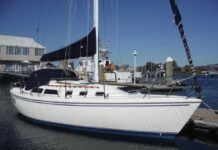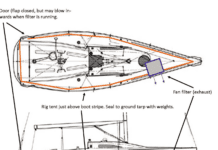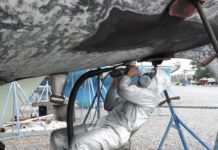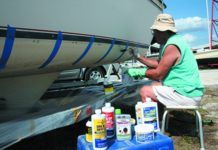Re-Bunging That Teak Deck
What do you suggest as an adhesive/sealant for replacing plugs in teak decks? I have been using epoxy, but I suspect it may eventually become brittle. I am reluctant to use black caulk since it is probably difficult to remove from the wood around the holes for the plugs.
-Jim Yeager
Marsh Harbour, B.I.
Practical Sailor published in the Nov. 1, 1993 Nick Nicholson’s long and thorough discussion about teak decks. As Nick pointed out, nothing is quite as beautiful as a new teak deck. The problem is that once exposed to the elements, a teak deck will never, ever look as good again. No matter what you do or slap on the teak, its all downhill from Day One.
On the other hand, nothing is quite as good underfoot as a teak deck. It’s arguably the best non-skid surface, wet or dry, ever laid on a boat.
An entire industry popped up to repair teak decks when they got old. The repairs were necessitated mostly by bungs that started to leak or seam compound that pulled away from the wood. The aging was accelerated by owners or crews who went at the decks with acid-based cleaners. About 10 years ago, Nautor, the builder of Swans, went to vacuum-bagged teak decks. As Nick explained, most deck teaks now are glued in place with as few fasteners as possible.
You’re right, Jim, in assuming that regular epoxy is not a good idea. Its consistency can be troublesome. When it kicks, it gets quite thin. Sunlight gets to it, sooner or later, and it will crack like peeling varnish. It may take years, depending on the thickness of the epoxy and the amount of direct sunlight it gets, but it’ll happen. (We know one teak deck owner who, faced with recaulking and bunging the deck of his ketch, mixed powered carbon in with the epoxy, not only to make it black but to counter the sunlight. He said it’s been about nine or ten years and the stuff is still tight as a drum.)
Perhaps the best-known experts are the folks at Teakdecking Systems (www.teakdecking.com/) in Sarasota, Florida. Technician Bob Nedswick said the company offers a special epoxy that doesn’t get as brittle. He said they’ve seen it last 15 to 18 years. The two-part, one-gallon kit costs $75, but you can mix the 1:1 components with any convenient container. Nedswick said you can buy smaller quantities (in pint and half-pint kits).
For those undertaking more extensive teak deck repairs, Teakdecking Systems also makes an interesting fitting and fairing compound made of epoxy mixed with microballoons. It’s intended to level out any unevenness of the deck on which the teak is to be attached.
Jim, you can if you like call 941/756-0600 and talk it over with Bob Nedswick.
———-
Converting to a Dual AC Voltage System
Was it really necessary for Nick Nicholson to install another inlet in order toconvert Calypso’s AC shore power systm into dual voltage system? Wasn’t it possible to use his existing inlet with just a change over switch?
What kind ofset-up do you suggest for a dual-voltage system if you are toinstall it in a new boat? (Our AC appliances are 110 volt, with inverter/charger. A gen-set may be installed in future.)
-Kazumaza Tada
Via e-mail
Nick Nicholson replies: Although we briefly considered it, using a single, switched inlet for both 110 and 220 volts is a recipe for disaster. If you accidentally leave the switch in the 110-volt mode when plugged into 220 volts, you are likely to fry a lot of equipment and have a good chance of burning up your boat. Electrical systems must be designed to be idiot-proof, as sooner or later we all do something really stupid.
Not only should you have two shore power inlets, they should have different plug types, so there’s no way you can accidentally plug the wrong voltage into an inlet. In the U.S., you can at least get shore powerinlets that match in style for both input voltages, which we were unable to do when we installed our 220-volt system in Australia.
There is an additional caveat. While a step-down isolation transformer is essential for changing voltage, the frequency of the stepped-down voltage is the same as the frequency of the shore power you plug into. Most U.S.-built appliance motors are wound for 60 cycles, and will overheat and run more slowly on 50 cycles.
If we were building a new boat, we would look hard for motors rated for both 50 and 60 cycles on majorappliances or systems such as microwaves, AC refrigeration, and air conditioning.
Resistance loads, such as electric water heaters, run fine on 50 or 60cycle power. Ironically, electronics rated for multiple voltages-televisions and computers, for example-are also usually rated for multiple frequencies, and have no problem with 50-cycle or 60-cycle power.
We do not run our microwave oven or AC refrigeration directly from 50-cycle shore power, even when it’sstepped down to 110 volts. Instead, we use our Heart Freedom 20 battery charger-which will run on either 50or 60 cycles-to charge the batteries, then use the inverter to run frequencysensitive appliances. This obviously requires a bit of power management.
We would also suggest installing a switch between the shore power inlet and the transformer, so that you canshut the transformer off when it’s not in use without unplugging or turning off the power ashore.
Transformers run quite hot, even when you’re not using power on the boat. You should also carry a blank shore power cable, with only the boat end of the cable pre-wired, so youcan install the myriad of adapters you will need for world-wide operation. We now have about a dozenadapters for various shore-side plug-ins: You just go into a hardware store or electrical supply store wherever you are and buy the local plug off the shelf.
We carry a 100-ft heavy-duty U.S.-made conventional orange exterior-use extension cord-with suitable endfittings installed-for use with 220-volt shore power overseas. In other countries, you may not be withinthe 50-ft distance of an outlet that you usually are in a U.S. marina, so you will either need a longer cableor multiple cables joined together. Since for a given load the cable is carrying half the amperage at 220volts it would at 110 volts, the cable need not be as heavy for a given length as it would be for the samewattage at 110 volts.
The ultimate shore power system is the “black box” used by big motoryachts and sailing yachts. Thesedevices will accept virtually any input voltage or frequency, and convert it into whatever voltage andfrequency you need for the ship’s systems.
The problem is size, weight, and cost. The smallest we have seenadvertised, from Global Power Systems, is the size of a suitcase, weighs 180 pounds, and is rated for 12 KVA(12 kilowatts). By comparison, our transformer has a three-hour rating of 3 KVA and weighs about 70 pounds.
The Florida distributor for Global Power Systems is Yacht Equipment and Parts, 3330 SW 3rd Avenue, Ft.Lauderdale, FL 33315, phone 800/349-9224.
We’re currently designing the electrical system for our next boat, and it’s a real challenge to come up with the most efficient and cost-effective system for both on-board and shore power operation.
You might say that ideally you would never need to go alongside and plug into the shore, but that is a nave assumption. In some areas of the world-Singapore, for example-you have few choices other than to go into a marina.
Once there, your neighbors will appreciate it if you don’t have to run either your main engine or a generator on a regular basis.
———-
DC-Powered Vacuums
Have you ever reviewed 12-volt vacuums? If not I would really like suggest one. I see a couple of models at BoatUS, but I was wondering how these may compare to auto vacs. Maybe a Dirt Devil would be better with an inverter. (Ive been lookingfor an excuse to buy an inverter.)
-Mark Clayton
Sudbury, MA.
A standard car vacuum with 12V cigarette lighter adapter works fine for light duty-bread crumbs and sawdust. Another option is to get the inverter (a $40 modified sine-wave model from an auto-parts store will do fine if your needs arent sophisticated) and plug the AC adapter for a rechargeable DC hand vacuum (like a Black & Decker Dustbuster) into it. The third option, as you note, is to run a standard AC-powered hand vac (likely to be the most powerful) through the inverter, or through shore power if available.
West Marine sells a canister-type 12V Wet/Dry vacuum by C.E. Smith. It draws 14 amps, carries a 40″ hose, a 15′ power cord with a cigarette lighter adapter, and has various attachments. At $32.50 it’s priced very well, and the ability to wet-vacuum a bilge space is appealing. It’s rotund, however, and would be bulky to stow on a small boat with all its attachments.
Here’s what to do: 1. Get the inverter anyway; you’ll find plenty of uses for it. 2. Get a decent 12V auto vac with a lighter plug. 3. Keep the bilge clean so you won’t regret not getting the wet/dry vac.
———-
Navy Blue Topsides
I have a 1984 30′ Catalina. I have admired some of the other boats inthe marina with navy blue hulls. Is there any disadvantage in having adark-colored hull? Assume that at the next haul-out, we paint the bottomwith a good rust-colored copper paint. I would like to then put a red barat and above the waterline and then paint the balance of the hull navy blue.My boat partner isn’t opposed to the color scheme, but feels there is somepractical advantage to a white hull above the waterline. The boat is keptat the marina in Santa Barbara, CA-so the weather is mild to warm all yearand there is plenty of sunshine.
-Zel Canter
Solvang, CA
Common wisdom has it that there are three disadvantages to dark topside paint: 1. It absorbs more sunlight, making the interior of the boat warmer. 2. Because it gets hotter, it deteriorates sooner that white or light-colored topside paints. 3. It shows salt, stains, and dings more than white paint.
Now that we have common wisdom out of the way… A copper-colored bottom, bright red bootstripe, and navy hull would look excellent. High-quality topside paint these days is tough as nails. It can be washed down when it gets salty, and the shinier it is, the more light it will reflect. For that matter, a blue hull looks pretty good when salt-coated, too. Go for it.
———-
Cavitation
On my dock, we’ve been arguing half the summer about propeller cavitation. A big group says the bubbles are air sucked in when the prop runs out of water. Another friend and I claim the bubbles are vacuums. There are some wagers here. We’ve agreed that what Practical Sailor says will settle it. Do you know who’s right?
-Erving Strauss
Portland, Maine
Well, we didn’t, but we do now, after reading Nigel Warrens Metal Corrosion in Boats, and checking with Britannica. You’re on the mark, Erving: Cavitation comes from partial vacuums being formed by the prop. The water literally boils, but without heat. When the vacuum bubbles collapse, they can implode on the prop blades and actually nick out bits of metal as well as cause damage to bearings and the like. This isn’t usually a problem for us blowboaters, but it can ruin a submariner’s day.





































